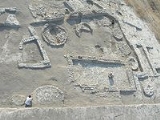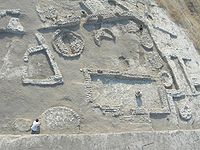
Tel Tsaf
Encyclopedia

Jordan Valley (Middle East)
The Jordan Valley forms part of the larger Jordan Rift Valley. It is 120 kilometers long and 15 kilometers wide, where it runs from Lake Tiberias in the north to northern Dead Sea in the south. It runs for an additional 155 kilometer south of the Dead Sea to Aqaba, an area also known as Wadi...
, south-east of Beit She'an. It was first tested in 1978–1980 by Ram Gophna of Tel Aviv University
Tel Aviv University
Tel Aviv University is a public university located in Ramat Aviv, Tel Aviv, Israel. With nearly 30,000 students, TAU is Israel's largest university.-History:...
. In 2004–2007 a large excavation project was conducted at the site by Yosef Garfinkel
Yosef Garfinkel
Yosef Garfinkel is a professor of Prehistoric Archaeology and of Archaeology of the Biblical Period at the Hebrew University of Jerusalem.-Biography:...
of the Hebrew University of Jerusalem. Tel Tsaf is dated to ca. 5200–4700 BC, sometimes called the Middle Chalcolithic, a little known period in the archaeology of the Levant
Levant
The Levant or ) is the geographic region and culture zone of the "eastern Mediterranean littoral between Anatolia and Egypt" . The Levant includes most of modern Lebanon, Syria, Jordan, Israel, the Palestinian territories, and sometimes parts of Turkey and Iraq, and corresponds roughly to the...
, post-dating the Wadi Rabah phase and pre-dating the Ghassulian
Ghassulian
Ghassulian refers to a culture and an archaeological stage dating to the Middle Chalcolithic Period in the Southern Levant...
Chalcolithic phase.
Discoveries
The excavations unearthed four architectural complexes. Each consists of a closed courtyard with rounded or rectangular rooms and numerous rounded silos. Four burials were found within or adjacent to silos. Outside the settlement a well was cut into the water table, approximately 6.5 m in depth.
Flint
Flint is a hard, sedimentary cryptocrystalline form of the mineral quartz, categorized as a variety of chert. It occurs chiefly as nodules and masses in sedimentary rocks, such as chalks and limestones. Inside the nodule, flint is usually dark grey, black, green, white, or brown in colour, and...
s, pottery and animal bones. The terms “Tel Tsaf Decoration” or “Tsafian” were derived from an assemblage of painted pottery, consisting mainly of relatively elaborate vessels bearing geometric decoration using red and black paint on a white slip background. The decoration was executed in two steps: first, white wash was applied to the upper part of the vessel, while the lower part was covered with red wash. Second, the patterns were painted in continuous horizontal bands on the upper part of the vessel. The painting was executed with a fine brush, in some cases 0.5 mm.
Other finds included about 150 clay sealings (bullae) and a rich assemblage of imported exotic items including artifacts of basalt
Basalt
Basalt is a common extrusive volcanic rock. It is usually grey to black and fine-grained due to rapid cooling of lava at the surface of a planet. It may be porphyritic containing larger crystals in a fine matrix, or vesicular, or frothy scoria. Unweathered basalt is black or grey...
and obsidian
Obsidian
Obsidian is a naturally occurring volcanic glass formed as an extrusive igneous rock.It is produced when felsic lava extruded from a volcano cools rapidly with minimum crystal growth...
, beads, sea shells, Nilotic
Nilotic
Nilotic people or Nilotes, in its contemporary usage, refers to some ethnic groups mainly in South Sudan, Uganda, Kenya, and northern Tanzania, who speak Nilotic languages, a large sub-group of the Nilo-Saharan languages...
shell, and a few pottery sherds of the Ubaid culture of north Syria
Syria
Syria , officially the Syrian Arab Republic , is a country in Western Asia, bordering Lebanon and the Mediterranean Sea to the West, Turkey to the north, Iraq to the east, Jordan to the south, and Israel to the southwest....
. This is the first reported occurrence of Ubaid sherds in an excavation in the southern Levant.
Silos
The silos are cylindrical, barrel-shaped structures with an outer diameter between 2 and 4 m. The base is a podium, probably built to protect the cereals from rodents. It consists of several courses of bricks sealed inside with lime plaster. The silos demonstrate several universal principles guiding the construction of silos worldwide, past and present: 1. Rounded sides, giving the structure a cylindrical shape. This form better withstands the pressure exerted by the contents, which is distributed evenly onto the sides of the silo and does not create excessive stress at the base or the corners as is the case with a rectilinear shape. 2. Building of a number of silos near one another allows for greater ease of handling than one big installation. This facilitates separation of grain from different years or different crops. In the event of fire, humidity, rodent or insect infestation, some of the stored grain may be spared. 3. Organization of silos in adjacent rows facilitates their arrangement within a confined space. The stability of silo shape over considerable periods of time and large geographical regions provide an outstanding case in human architecture.See also
- Cities of the ancient Near EastCities of the ancient Near EastThe largest cities in the Bronze Age ancient Near East housed several tens of thousands. Memphis in the Early Bronze Age with some 30,000 inhabitants was the largest city of the time by far...

